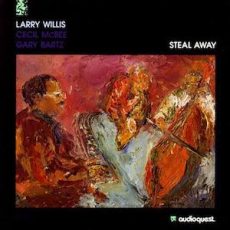
Requisites
Steal Away ~ Larry Willis | By Eddie Carter
This morning’s album from the library is Steal Away (AudioQuest Music AQ-LP 1009), a little-known release by pianist Larry Willis. It’s the first of two records Willis made for the label and his seventh as a leader. He’s joined on this date by Gary Bartz (tracks: A2, B1) on alto sax and Cecil McBee (A2, B1, B2) on bass. My copy is the 1992 U.S. Stereo audiophile album.
Side One opens with Valdosta Blues by Larry Willis, the first of three solo piano performances. The title comes from the city in Georgia and begins with the pianist’s tranquil introduction that builds to a breezy melody. His ensuing solo is a superb performance that moves easily toward an exquisite ending.
The title tune, Steal Away, is an American Negro spiritual by Wallace Willis. It has been with Larry since age three and was a favorite song of his Mother’s to sing. Willis opens with a delicately gentle introduction to Bartz and McBee’s very pretty melody. Gary’s opening solo is imaginative and confident. Larry follows with sweet notes that shine like the rays of the sun, and Cecil breezes blissfully through the closing statement into a gentle climax. Fallen Hero is Larry’s tribute to his brother Victor. He tells an intimate story that reveals his love and affection for his brother with reflective inspiration and tenderness.
“D” Bass-ic Blues by Cecil McBee starts with the bassist’s bowed introduction, setting up Bartz and Willis to join him in a medium-tempo theme. Larry eases into the first solo with joyful vitality. Gary keeps the ball rolling with a remarkable reading of melodic lines. Cecil lets his bass do the talking in the finale preceding the theme’s reprise and conclusion. Ethiopia is a hauntingly beautiful song by Larry Willis that’s presented as a duet with Cecil McBee. The duo starts with a tender melody, and then Larry’s opening statement is as gentle as a light summer rain. Cecil comes in next with a graceful interpretation ahead of the duo’s delicately pretty ending.
The Meaning of The Blues by Bobby Troup and Leah Worth is given a tasteful treatment by Willis. He makes the song his own in a solo showcase that’s warm and nostalgic, thoughtful and heartfelt into a serene finale of haunting dreaminess. Joe Harley produced Steal Away, Pierre M. Sprey was the recording engineer, and Bernie Grundman mastered the album. It’s a pure analog recording with a stunning soundstage that was pressed on 180 grams of audiophile vinyl and is a perfect demonstration record for any quality audio system. Larry Willis recorded twenty-one albums as a leader and many more as a sideman. If you’re a fan of piano jazz, I invite you to consider Steal Away by Larry Willis on your next record-shopping trip. It’s an excellent place to start your discovery of his music and a welcome addition to any jazz fan’s library!
~ Fallen Hero, Ethiopia, “D” Bass-ic Blues – Source: Album Liner Notes by Bill Kohihasse
~ American Negro Spirituals were songs that contained hidden codes and messages for enslaved people to escape on their own or through the Underground Railroad – Source: Wikipedia.org © 2023 by Edward Thomas Carter
More Posts: choice,classic,collectible,collector,history,instrumental,jazz,music,piano
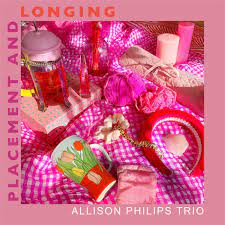
Daily Dose Of Jazz…
Allison Philips was born on December 8, 1991 in South Orange, New Jersey. She began playing the trumpet at the age of 9 and began performing regularly since she was fourteen. She went on to receive a BFA in Jazz Performance from the New School for Jazz and Contemporary Music of New York City and a Masters in Jazz Performance at The Conservatorium Van Amsterdam in Amsterdam, The Netherlands.
She has studied under several trumpet luminaries including Laurie Frink, Ingrid Jensen, Chris Jaudes, Tatum Greenblatt, Joe Magnarelli, Jimmy Owens, Ruud Breuls and Jan Oosthof.
From the traditional trio setting to genre-bending explorations via electronics, Allison is always searching for new ground. She has created her own trio, co-leads the DeiCont | Philips Collective, and both groups have toured domestically and throughout Europe and Canada.
She has performed with Sara McDonald’s “NY Chillharmonic”, The Chronometer’s Orchestra, Phil’s Music Lab, Charlie Rosen’s Broadway Bigband, the BVR Flamenco Orchestra, Zulema’s Mambo Queens, and many others.
Trumpeter, bandleader and educator Allison Philips continues to perform, record and tour.
More Posts: bandleader,history,instrumental,jazz,music,trumpet
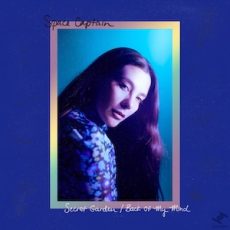
Daily Dose Of Jazz…
Gray Hall was born November 10, 1992 in Philadelphia, Pennsylvania. Learning to play the guitar as a youth, by the time he was in high school he was playing lead with Nathaniel’s jazz quartet and with Donnie in their modern blues group called Edens Unknown.
He and his high school classmates Alex Plye and Mike Haldelman while working with Marilisa Cook-Simmons on vocals, creating an electro-future-soul odyssey that blends the art of soul, production, and instrumentation that demonstrates the art of cool.
After graduating from Guilford College in Greensboro, North Carolina he rejoined his fellow musicians Pyle and Haldeman to produce and record tracks for the neo-soul jazz group Space Captain. Splitting his time between performing and recording in New York City and recording at the Great Time Studio in suburban Philadelphia.
Other studio work by Hall features original beats and soundtrack mastering for So Far Productions (NYC). He has studied guitar with Daniel Sheriff, Greg Hyslip, and Rory Stewart; and interned as an studio production assistant with Eddie Motilla of Universal Studios, NYC and The Record Room in Miami, Florida.
Guitarist Gray Hall, who works in genres ranging from modern jazz, jazz fusion, modern blues, and neo-soul, continues to perform, record and produce.
More Posts: bandleader,guitar,history,instrumental,jazz,music,producer
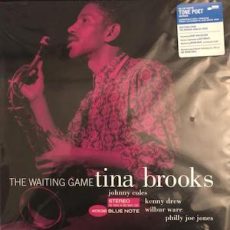
Requisites
The Waiting Game ~ Tina Brooks | By Eddie Carter
Tina Brooks enters this morning’s spotlight with what would be his final album, The Waiting Game (Blue Note TOCJ-66075). He recorded exclusively for Blue Note over three years as a leader and sideman, but only one of his records, True Blue, would be released during his lifetime. This morning’s album initially hit the Japanese stores in 1999 as a CD album and reached the US a few years later. Joining the tenor saxophonist is a superb supporting cast: Johnny Coles on trumpet, Kenny Drew on piano, Wilbur Ware on bass, and Philly Joe Jones on drums. My copy is the 2021 Blue Note Tone Poet Series Stereo audiophile reissue (BST-40536).
Side One starts with Talkin’ About, the first of five tunes by Tina Brooks. The rhythm section’s introduction segues into the quintet’s easygoing melody. Johnny has the first relaxing solo; and then Tina delivers the next message comfortably. Kenny follows with a laid-back reading, and Wilbur goes for an easy stroll into the ensemble’s reprise. One For Myrtle picks up the pace significantly from Philly’s brief introduction to the group’s brisk theme. Tina launches the solos; then Johnny shows his energetic exuberance next. Kenny follows with a sizzling reading. Wilbur is up next with a quick flight, and Philly turns in an exciting finale ahead of the theme’s restatement and abrupt ending.
Dhyana opens with the ensemble swinging easily on the danceable melody. Tina gets things going with a splendid opening statement. Johnny follows with a delightful reading, and Kenny closes with an exceptional solo. The quintet’s closing chorus features a brief comment by Wilbur just before the climax. Side Two comes to life with the front line and Philly collaborating in the introduction to David The King ahead of the quintet’s Middle Eastern theme. Johnny takes the song’s first stirring solo. Tina sails smoothly into the second statement. Kenny delivers a dazzling reading of his own, and Wilbur takes a short, satisfying walk toward the song’s conclusion.
Stranger In Paradise by Chet Forrest and Robert Craig Wright begins with a brief introduction by Philly that blossoms into Tina and the rhythm section stating the melody. Johnny steps up first with an impressive statement. Tina swings skillfully next, and Kenny glows brightly on the closer, leading to the reprise and gentle fadeout. The Waiting Game kicks off with the ensemble’s invigorating beat to the melody. Tina blows with feeling in the first solo spot, paving the way for Johnny’s spontaneous ideas that flow constantly. Kenny ends with a few marvelously executed ideas before the theme’s restatement and abrupt halt.
Alfred Lion produced the original session, and Rudy Van Gelder was the recording engineer. Joe Harley produced the audiophile reissue, and Kevin Gray mastered this album. The reissue’s sound quality is amazing, with a stunning soundstage and excellent dynamics. The pressing is extremely quiet until the music starts. The gatefold photos are breathtaking and worthy of hanging on your wall. The front and rear covers are gorgeous, and the use of 180-gram audiophile vinyl is the icing on the cake. If you’re in the mood for an excellent album by one of the best, underrated tenor saxophonists, I invite you to check out The Waiting Game by Tina Brooks on your next record-shopping trip. It’s a great album if you love jazz and are a hard-bop fan that’s highly recommended for a spot in your library!
~ True Blue (Blue Note BLP 4041/BST 84041) – Source: Discogs.com ~ Stranger In Paradise – Source: Wikipedia.org © 2023 by Edward Thomas Carter
More Posts: choice,classic,collectible,collector,history,instrumental,jazz,music,saxophone
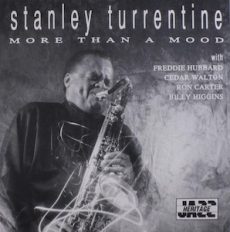
Requisites
More Than a Mood ~ Stanley Turrentine | By Eddie Carter
After the enormous success of Sugar in 1971, tenor saxophonist Stanley Turrentine began moving in a different direction towards smooth jazz and jazz funk. Two decades later, he returned to his bop roots with three CD albums for the MusicMasters Jazz label. This morning’s discussion hit the stores in 1992. More Than a Mood (Jazz Heritage 913307A) puts the listener in mind of his sixties Blue Note LPs. On this date, he is working with a superb quartet, Freddie Hubbard on trumpet (track: A1) and flugelhorn (B3), Cedar Walton on piano, Ron Carter on Bass, and Billy Higgins on drums. My copy is the 1993 US Stereo release.
The first side gets underway with Thomasville by Tommy Turrentine (Stanley’s brother), with the rhythm section fueling the frontline’s invigorating melody. Stanley reaches a height of feisty excitement. Freddie follows with a scintillating performance; then Cedar delivers an exciting improvisation. Billy enters the spotlight with vigorous enthusiasm on the finale, leading to the closing chorus. They Can’t Take That Away From Me by George, and Ira Gershwin is a quartet highlight for Turrentine and the trio, who set the pace with a beautiful melody. Stanley applies a nostalgic touch to the opening solo with a splendid presentation. Cedar responds with a delicious interpretation ahead of the reprise and soft summation.
In a Sentimental Mood by Duke Ellington, Irving Mills, and Manny Kurtz is one of The Great American Songbook’s most recorded jazz and pop standards. The quartet’s rendition begins with a concise introduction by Cedar that opens the way for Stanley’s lovely melody and delicately gentle opening statement. Cedar is up next and delivers an elegant interpretation that’s a marvel to behold. Stanley returns with a few distinctive comments preceding the foursome’s delicately gentle climax. Easy Walker by Billy Taylor and Teddy Castion moves the quartet back to a medium tempo for Turrentine’s excellent execution of the melody and opening solo. Walton moves in next with an impressive statement, then Higgins takes care of business into the closing chorus and conclusion.
To begin Side Two, the quartet tackles the Bossa Nova song, Triste, by Antônio Carlos Jobim. The title’s definition in English is sad, and it’s one of Jobim’s best-known compositions. He first recorded it in 1967, and the quartet’s rendition begins and ends with two festive opening and closing choruses. Stanley and Cedar are the featured soloists, and both give spirited readings sustained by Ron and Billy’s groundwork. Pieces of Dreams by Alan Bergman, Marilyn Bergman, and Michael Legrand commences with the trio’s introduction segueing into Turrentine’s elegant theme and pretty thoughts on the opening reading. Walton carries the ball with a presentation of pure beauty leading to the ensemble’s ending theme.
Spirits Up Above by Rahsaan Roland Kirk brings back Freddie Hubbard and displays his flugelhorn at its most beguiling. The opening melody flows with the warm, mellow tones of the front line’s gentle message over the rhythm section. Turrentine is up first and crafts a reading as sweet as honey. Walton achieves a very intimate feeling on the second statement, and Hubbard infuses the closer with sentimental warmth into the quintet’s theme reprise and poetic fadeout. The title tune, More Than A Mood, by Frank Marino and Bill Simon, brings the album to a close with a slow tempo that affords Stanley the solo spotlight alone. The trio opens this song peacefully, and Stanley responds with a gorgeous melody and alluring statement culminating with a sensuously tender closing chorus and fading out of sight.
Joe Delia produced More Than a Mood, and the recording engineer was Jimmy Douglass. The record has superb sound quality, and the music is excellent throughout. Stanley dedicated this album to his brother Tommy and fellow saxophonists Don Byas and Rahsaan Roland Kirk, and it recaptures the spirit of his Blue Note records with inspired performances. If you’re new to the music of Stanley Turrentine or are already a seasoned fan, I invite you to check out More Than a Mood on your next vinyl hunt. Sadly, the record label Jazz Heritage no longer exists, so the album may be difficult to find, but it’s worth seeking out for a spot in your library and is sure to make you smile once you do!
~ More Than a Mood (MusicMasters Jazz 01612-65079-2), Wave (A&M Records SP-3002) – Source: Discogs.com ~ In a Sentimental Mood, They Can’t Take That Away From Me – Source: JazzStandards.com ~ Pieces of Dreams, Triste – Source: Wikipedia.org ~ © 2022 by Edward Thomas Carter
More Posts: choice,classic,collectible,collector,history,instrumental,jazz,music,saxophone



